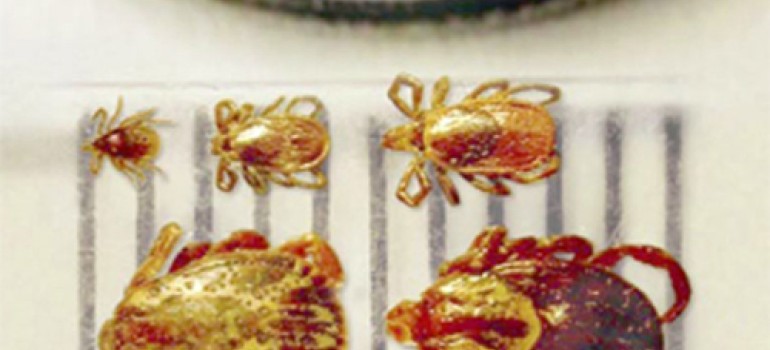
How to protect yourself from blacklegged ticks and Lyme disease
With warm temperatures and busy beaches, it’s obvious that summer is in full swing in Nova Scotia. And as the temperatures rise, so does the population of blacklegged ticks.
Blacklegged ticks become active when the outside temperature is consistently above four degrees Celsius. This means that your risk of a tick bite is highest in the spring and summer months.
Unfortunately, with blacklegged ticks comes the risk of Lyme disease.
Lyme disease is a serious illness that is spread by the bite of infected blacklegged ticks. Ticks stick to skin and feed on blood. A tick carrying the bacteria that can cause Lyme disease can only transmit it after filling itself with blood, which takes at least 24 hours.
In Nova Scotia, only the blacklegged tick carries the bacteria that causes Lyme disease, and not all blacklegged ticks carry the bacteria. From 2002 to 2014, there was a total of 443 cases of Lyme disease reported in Nova Scotia. In 2014 alone, there were 114 cases reported. It’s expected the number of cases will increase over time as ticks become more densely populated and expand their geographical range.
Where are blacklegged ticks in Nova Scotia?
Blacklegged ticks have been found across the province and most often near wooded areas. They survive best in areas that provide a moist habitat. Wooded or forested areas are very suitable as the trees provide shade and leaf litter ground cover for protection.
There are six areas across the province where the risk is higher:
- Areas of Yarmouth County
- Areas of Pictou County
- Areas of Lunenburg County
- Areas of Queens County
- Areas of Halifax Regional Municipality
- Areas of Shelburne County
This map shows areas where there are established populations of blacklegged ticks that carry the bacteria that can cause Lyme disease. However, ticks could be anywhere and it is best to take precautions whenever working or playing outdoors.
What is Lyme disease?
Lyme disease is a bacterial illness that can be transmitted to humans through the bite of a blacklegged tick, also known as deer tick. There are a number of tick species in Nova Scotia, but only the blacklegged tick can carry the bacteria that can cause Lyme disease.
Ticks stick to skin and feed on blood. A tick that carries the bacteria can only transmit Lyme disease after it has filled itself with blood, which takes at least 24 hours.
Not all blacklegged ticks carry the bacteria and the risk of acquiring Lyme disease remains low in the province. Lyme disease is readily treatable with appropriate antibiotics. The earliest and most common symptom of Lyme disease is a bull’s-eye rash at the site of the bite. Other symptoms include fever, fatigue, muscle aches and headaches.
If you have been in a grassy or wooded area and have flu-like symptoms and/or a rash (particularly a bulls-eye shaped rash), you should seek prompt medical attention.
Preventing Lyme disease
The best way to prevent Lyme disease is to avoid blacklegged tick bites, checking often for ticks and removing them before they bite.
If you live or play in areas where blacklegged ticks are present, you should protect yourself by:
- Using insect repellent containing DEET
- Cover as much of your skin as possible when walking, working, or playing in areas where ticks are found. Wear enclosed shoes, tuck your shirt into your pants, and tuck your pant legs into your socks.
- Wear light-coloured clothing with a tight weave to see ticks more easily.
- Walk on well-travelled paths away from high grass and other vegetation.
- Check your clothing, bare skin, including arm pits, groin and scalp.
- Remove ticks by carefully grasping the tick with tweezers as close to the skin as possible and pulling the tick straight out.
- Disinfect the site with soap and water, alcohol or hydrogen peroxide.
- Keep grass well cut to minimize suitable habitat for ticks on your property.
- Removing ticks as soon as possible can prevent or reduce the risk of infection, since blacklegged ticks can only transmit the bacterial infection after they have been attached to the skin for at least 24 hours.
Treatment
Ask your family doctor for information about treatment for Lyme disease. If you don’t have a family doctor, contact the Nova Scotia Health Authority to inquire about physicians in your area who are accepting new patients.
Pets & Lyme disease
Although pets, particularly dogs, can contract Lyme disease, there is no evidence that they can spread the infection directly to people.
It’s important to help your pets avoid Lyme-infected tick bites by keeping them out of the woods and performing regular tick checks. While pets can’t transmit the infection directly to people, they can carry ticks into homes and yards.
Performing a tick check on your pet after being outside is the best protection for both your pet and your family.
The most common symptom of Lyme disease in pets is arthritic pain, with some having fatigue and fevers. Contact your veterinarian if you suspect your pet may have Lyme disease.
For up to date information on Lyme disease in Nova Scotia, visit:
Nova Scotia Department of Health and Wellness
Government of Canada
